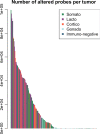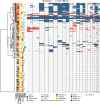Chromosomal instability in the prediction of pituitary neuroendocrine tumors prognosis
- PMID: 33168091
- PMCID: PMC7653703
- DOI: 10.1186/s40478-020-01067-5
Chromosomal instability in the prediction of pituitary neuroendocrine tumors prognosis
Abstract
The purpose of this study was to analyze the impact of copy number variations (CNV) on sporadic pituitary neuroendocrine tumors (PitNETs) prognosis, to identify specific prognosis markers according to the known clinico-pathological classification. CGH array analysis was performed on 195 fresh-frozen PitNETs (56 gonadotroph, 11 immunonegative, 56 somatotroph, 39 lactotroph and 33 corticotroph), with 5 years post-surgery follow-up (124 recurrences), classified according to the five-tiered grading classification (invasion, Ki-67, mitotic index and p53 positivity). Effect of alterations on recurrence was studied using logistic regression models. Transcriptomic analysis of 32 lactotroph tumors was performed. The quantity of CNV was dependent on tumor type: higher in lactotroph (median(min-max) = 38% (0-97) of probes) compared to corticotroph (11% (0-77)), somatotroph (5% (0-99)), gonadotroph (0% (0-10)) and immunonegative tumors (0% (0-17). It was not predictive of recurrence in the whole cohort. In lactotroph tumors, genome instability, especially quantity of gains, significantly predicted recurrence independently of invasion and proliferation (p-value = 0.02, OR = 1.2). However, no specific CNV was found as a prognostic marker. Transcriptomic analysis of the genes included in the CNV and associated with prognosis didn't show significantly overrepresented pathway. In somatotroph and corticotroph tumors, USP8 and GNAS mutations were not associated with genome disruption or recurrence respectively. To conclude, CGH array analysis showed genome instability was dependent on PitNET type. Lactotroph tumors were highly altered and the quantity of altered genome was associated with poorer prognosis though the mechanism is unclear, whereas gonadotroph and immunonegative tumors showed the same 'quiet' profile, leaving the mechanism underlying tumorigenesis open to question.
Keywords: Copy number variations; Genomic instability; Pituitary adenoma; Pituitary neuroendocrine tumors; Prognosis.
Conflict of interest statement
The authors declare no potential conflicts of interest.
Figures
References
-
- Asioli S, Righi A, Iommi M, Baldovini C, Ambrosi F, Guaraldi F, Zoli M, Mazzatenta D, Faustini-Fustini M, Rucci P, Giannini C, Foschini MP. Validation of a clinicopathological score for the prediction of post-surgical evolution of pituitary adenoma: retrospective analysis on 566 patients from a tertiary care centre. Eur J Endocrinol. 2019;180:127–134. doi: 10.1530/EJE-18-0749. - DOI - PubMed
-
- Bi WL, Greenwald NF, Ramkissoon SH, Abedalthagafi M, Coy SM, Ligon KL, Mei Y, MacConaill L, Ducar M, Min L, Santagata S, Kaiser UB, Beroukhim R, Laws ER, Dunn IF. Clinical identification of oncogenic drivers and copy-number alterations in pituitary tumors. Endocrinology. 2017;158:2284–2291. doi: 10.1210/en.2016-1967. - DOI - PMC - PubMed
-
- Bi WL, Horowitz P, Greenwald NF, Abedalthagafi M, Agarwalla PK, Gibson WJ, Mei Y, Schumacher SE, Ben-David U, Chevalier A, Carter S, Tiao G, Brastianos PK, Ligon AH, Ducar M, MacConaill L, Laws ER, Santagata S, Beroukhim R, Dunn IF. Landscape of genomic alterations in pituitary adenomas. Clin Cancer Res Off J Am Assoc Cancer Res. 2017;23:1841–1851. doi: 10.1158/1078-0432.CCR-16-0790. - DOI - PMC - PubMed
Publication types
MeSH terms
Substances
LinkOut - more resources
Full Text Sources
Medical
Molecular Biology Databases
Research Materials
Miscellaneous





